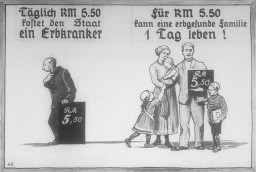
Nazi Racism
The Nazis believed that the world was defined by a struggle among races. Nazi racism drew on widespread, popular ideas about race and biology.
Nazi Racism Nazi beliefs and ideas about race shaped all aspects of everyday life and politics in Nazi Germany. In particular, the Nazis embraced the false idea that Jews were a separate and inferior race. This belief is known as racial antisemitism.
The combined set of Nazi beliefs and ideas about race is sometimes referred to as “Nazi racism” or “Nazi racial ideology.” Like other forms of racism, Nazi racism was based on prejudices and stereotypes.
The Nazis drew upon ideas about race that were widespread throughout much of Europe and North America. However, the specifics of Nazi racism were extreme. They were based on Adolf Hitler’s interpretation of race. In his book Mein Kampf (1925), Hitler explained his racist worldview. He idealized racial purity and racial struggle. After the Nazis came to power in Germany, these ideas drove government policy. Hitler’s ideas about race have been widely discredited as incorrect and immoral.
Nazi racism resulted in the persecution and mass murder of six million Jews and millions of other people.
Introduction to Nazi Racism
Adolf Hitler and the Nazis believed that the world was divided into distinct races.
According to the Nazis, each race had its own traits. These characteristics, in the Nazi view, were passed on from one generation to the next. All members of a race supposedly shared the same inherited traits. These traits then supposedly determined the race’s appearance, intelligence, creativity, and strength.
Some races, in the Nazi view, had better traits than others. According to Nazi thinking, the races with the best traits dominated other races.
Nazi Ideas about the Aryan Race
Hitler and the Nazis identified Germans as members of the “Aryan” race. According to the Nazis, Aryans were at the top of the racial hierarchy. This is why the Nazis referred to German Aryans as the “master race.”
The Nazis idealized Aryans as blonde, blue-eyed, athletic, and tall. Nazi propaganda posters, photographs, and films showed people who fit this ideal. However, many people whom the Nazis considered to be Aryan Germans did not look like this. For example, Adolf Hitler had brown hair and was average height. The Nazis did not persecute or murder people solely based on hair or eye-color.
The Nazis believed that they had to protect Germans from inferior races. To stay strong, they thought they had to remain racially pure. To Hitler and the Nazis, Jewish people were the biggest threat to the Aryan race.
Nazi Racial Discrimination against Jews
The Nazis defined Jews by race, not religion. They claimed that Jews belonged to a separate race. They also claimed that Jews were inferior to all other races. The Nazi definition of Jews included people who did not practice Judaism.
Hitler and the Nazis claimed that the “Jewish race” was especially dangerous. It supposedly exploited and harmed other races. Thus, the Nazis referred to Jews as a “parasitic race.” In particular, they believed that Jews were parasites that were destroying the Aryan race. This false and prejudiced belief was why the Nazis persecuted Jewish people. They wanted to separate Jews and Aryan Germans. They tried to force Jews to leave Germany.
The Nazis’ Failed Attempts to Measure and Identify Race
The Nazis tried to use science to prove their racial theories. They recruited doctors and other scientists to help them. These officials tried to categorize people into races. They measured and described people’s physical features, like noses, skulls, eyes, and hair.
These attempts at categorization failed to prove Nazi racial theories. In fact, their efforts revealed that human beings could not be scientifically categorized into races. Humankind is simply too naturally diverse. However, this reality did not stop the Nazis.
Nazi Racial Policies
Nazi racism determined how the Nazis treated people in Germany. People whom the Nazis identified as Aryans benefited from Nazi economic and social policies. Those whom the Nazis identified as non-Aryans (including Jews) were persecuted and discriminated against. For example, the Nuremberg Race Laws stripped Jews of the rights of citizenship. The laws also banned so-called race-mixing. In addition, the Nazis carried out forced sterilizations of certain groups whom they considered inferior. These procedures prevented people with disabilities, Roma, and Black people in Germany from having children.
Nazi Racial War
Nazi ideology, including Nazi racism, led to World War II (1939–1945).
War was part of Nazi racial theory. The Nazis believed that races were destined to wage war against each other. For them, war was a way for the Aryan race to gain land and resources. Specifically, the Nazis wanted to conquer territory in eastern Europe. They planned to remove, dominate, or murder the people who lived there. They believed that Aryan Germans should control this land because they were the supposed master race. The Nazis called this territory “living space” (Lebensraum). Hoping to achieve these goals, the Nazis invaded and occupied much of eastern Europe, beginning with Poland. In occupied eastern Europe, the Nazis behaved with extreme brutality. They oppressed and murdered civilians across the region.
The Holocaust and Nazi Racism
Nazi racism led to the mass murder of six million Jews. The Nazis falsely claimed that Jews were an inferior race. They also falsely claimed that all Jews were an existential threat to Germany and that they had to be destroyed. Motivated by this racist thinking, the Nazis carried out a genocide of Europe’s Jews during World War II. This genocide is referred to as the Holocaust.
Key Dates
July 1925
The first volume of Adolf Hitler’s Mein Kampf is published
Adolf Hitler writes a book called Mein Kampf while in prison for attempting to overthrow the German government. The title means “my struggle.” This book is part autobiography and part political manifesto. The first volume is published in July 1925 by the Nazi Party’s publishing house. The second volume is published the following year. In Mein Kampf, Hitler outlines his racist, antisemitic worldview. These ideas form the basis of Nazi ideology. They have deadly consequences after Hitler becomes chancellor of Germany in 1933.
April 7, 1933
Law for the Restoration of the Professional Civil Service
In April 1933, the Nazis enact their first national anti-Jewish law. This law is called “Law for the Restoration of the Professional Civil Service.” It allows the government to dismiss certain government workers, including Jews and political opponents. The Nazis claim that the law will make the government more reliable and efficient. In reality, this law is a purge. It is the Nazis’ first attempt to exclude Jews from German economic, social, and political life.
July 14, 1933
The Sterilization Law
On July 14, 1933, the Nazi German regime enacts a sterilization law. This law is called the “Law for the Prevention of Offspring with Hereditary Diseases.” It allows the government to forcibly sterilize Germans with certain diseases. In particular, the law applies to individuals diagnosed with nine medical conditions influenced by hereditary factors, including hereditary deafness, hereditary blindness, and schizophrenia. The Nazis sterilize about 400,000 people under this law.








